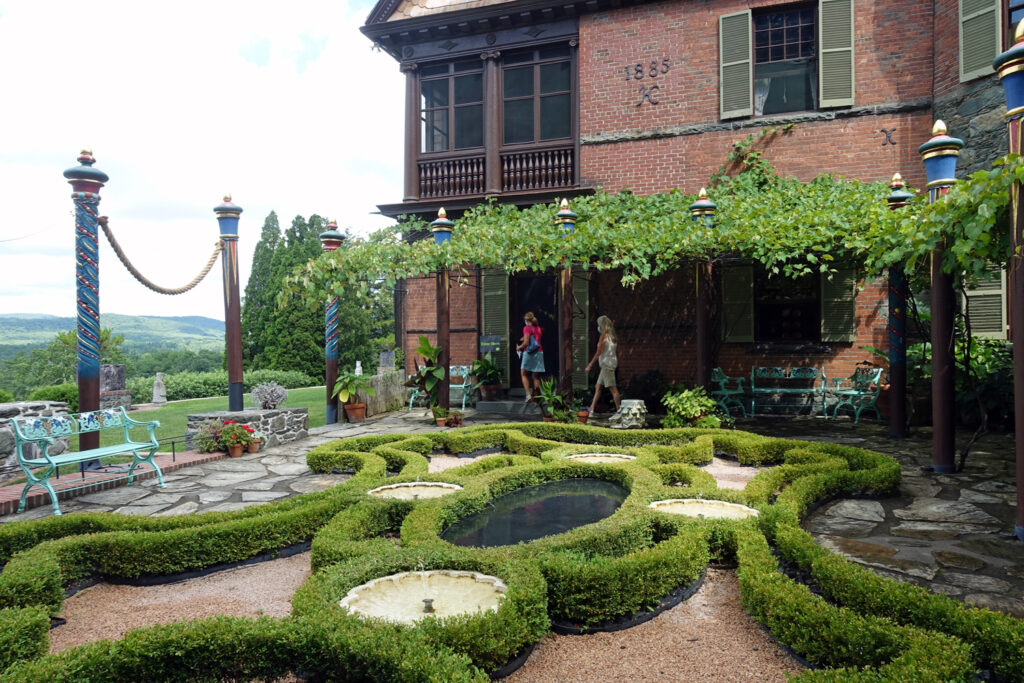In 2020, I emailed 157 art-related items to members of my free Sunday Recommendations list. (To join, just ask: DuranteDianne@gmail.com.) For supporters, I recommended 51 more items. The items in this and the preceding post are my own favorites. The 17 items that were originally shared only with supporters are marked with asterisks.
Music: Classical
Schubert, Franz. Symphony No. 9, “The Great” (Vienna Philharmonic conducted by Sawallisch; premiered 1825). Remember that ad where the power of the music from a JBL speaker is blowing the guy backwards? Putting Schubert’s “Great” on the house music system makes me feel like that. I heard Gerard Schwarz talk about this symphony in person once, and have loved it ever since. Alas, he doesn’t seem to have recorded that talk for Khan Academy.
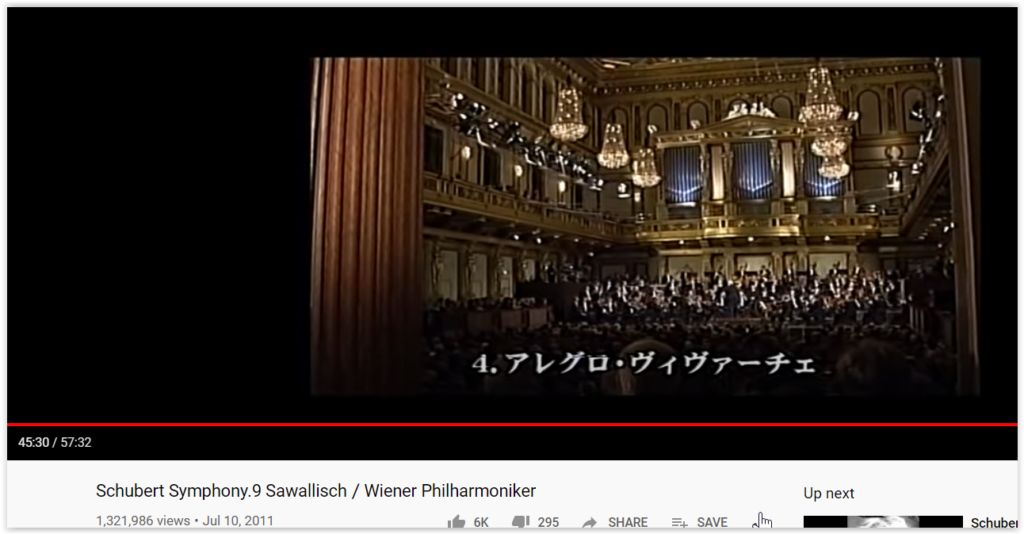
Runners-up:
- * Mozart, Wolfgang Amadeus. Eine Kleine Nachtmusik (1787). I’ve never recommended a Mozart piece in the Sunday Recommendations, which is very odd indeed since he’s one of my favorite classical composers. So: in 1787, around the time Mozart was working on Act II of Don Giovanni, he noted in his journal that he’d finished a piece he described as “Eine kleine Nacht-Musik” – a short serenade. We don’t know for whom it was written or when it premiered. His widow Constanze sold the manuscript of it in 1799, as part of a bundle of Mozart’s compositions. It was finally published in 1827. Today it’s one of Mozart’s most frequently performed compositions. I never tire of its effervescence. Think of this with two contemporary works: the Guardi painting and the sedan chair that appear in this week’s post on the Gardner Museum.
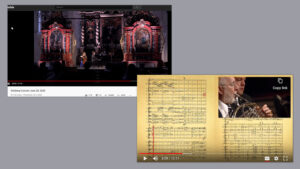
- * Beethoven, Ludwig von. Sonata No. 3 in A flat for Cello and Piano, Op. 69 (1808). Exquisitely performed at the Solsberg Festival in June 2020 (during the pandemic) by Sol Gabetta, violincello, and Seong-Jin Cho, piano.
- Schwarz, Gerard. Analysis of Johannes Brahms, “Academic Festival Overture” (2019). This piece was composed in 1880 when Brahms, in his forties, was given an honorary doctorate by the University of Breslau. It incorporates four drinking songs commonly sung by European students, including my personal favorite, “Gaudeamus igitur.” (It came up a few weeks ago in the Gary Cooper movie Ball of Fire, which is mentioned below.) Schwarz is brilliant at commenting on how the various sections of the orchestra are building suspense or working together. The video frequently shows the score with the part under discussion highlighted. For the full piece without commentary, conducted by Leonard Bernstein, see here. For those of you particularly curious: the first of the drinking songs is this, second this, third this, and the “Gaudeamus” is here. All Schwarz’s analyses are worth listening to: you can find them on the Khan Academy site.
Music: Broadway and Popular
A tie:
- * Home Free. “God Bless the U.S.A.” (2016). Fabulous a capella version of a song whose mood I appreciate, even though I don’t agree with every word. Don’t miss the reveal of where they’re performing, at about 0:55. HT Rand S.
- Capuçon, Gautier. “Hymne a l’amour” (Édith Piaf/Marguerite Monnot) (2020). I suppose some people can resist a handsome Frenchman playing cello on the Eiffel Tower. I can’t. The Edith Piaf song he’s playing is performed by Piaf in French here (lyrics in French here), by Cyndi Lauper here (lyrics in English here). HT Eric Moldenhauer in Wynand’s Gallery on Facebook for the recommendation of the Capuçon video.

Video: Movies
* The Big Country (1958). Directed by William Wyler; starring Gregory Peck, Charlton Heston, Burl Lives. Great story, excellent writing, very good acting and pacing, wonderful music (including the theme song). The official trailer spins it as a tale of sex, violence and horseback riding, but the real interest is in the characters and their dilemmas. Because movies require an investment of a couple hours of your time and I want you to make time to watch this one, I’ll tell you my favorite line: “I’m not responsible for what people think, only for what I am.” Burl Ives won an Academy Award for best supporting actor. It’s an indication of my (relative) youth that the first few times I heard his voice in this movie, I interpreted it as Frosty the Snowman being grumpy. Rudolph the Red-Nosed Reindeer came out in 1964. HT Kristina J. & Adam W.
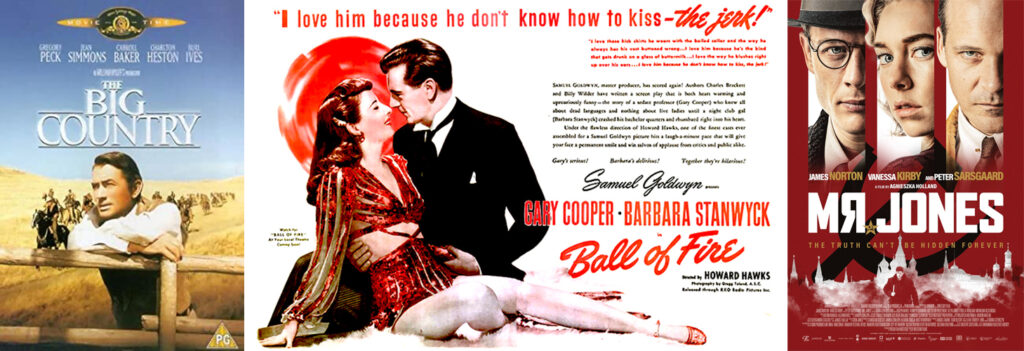
Runners-up:
- * Ball of Fire (1941). Romantic comedy with Gary Cooper and Barbra Stanwyck. A group of bachelors writing an encyclopedia consult a nightclub performer for the entry on current slang, and get involved with a murderous mob boss. I have a PhD in philology (literally “love of words”), so the premise attracted me, and Cooper’s description of why Pastrami is an idiot was worth the price of admission. Stanwyck steals every scene with joie de vivre and courage. Bonus: seeing New York City in the early 1940s, and hearing the “Gaudeamus igitur” sung twice. (See also the Brahms piece above.) We found this movie free via Hulu; it’s not available for streaming on Amazon or Netflix, and the YouTube version has a gap about halfway through.
- Mr. Jones (2019). Set in the USSR in the 1930s: a beautifully shot film of a devastating event, covered by a journalist with impeccable integrity. HT Yaron Brook.
Video: TV
Blue Bloods (10 seasons) (2011-2020). Principles, integrity, justice, and Tom Selleck. Highly recommended. HT Jean M.
Architecture
I made a point this year of including more architecture in the Sunday Recommendations. The winner is a tie: I love the interior of The Mount, the gardens of Naumkeag.
- * The Mount (1902). The Mount, home of novelist Edith Wharton (1862-1937), was completed in 1902. Of the three “Berkshire cottages” I visited in southwestern Massachusetts in summer 2020, this is the one I would most like to live in. In 1897, at age 30 – long before she became a well-known novelist – Wharton co-authored with architect Ogden Codman The Decoration of Houses. According to Mitchell Owens in Architectural Digest, “Wharton and Codman wanted to educate the rich, to challenge them to build beautiful, practical, and pleasing residences whose details, from meaningful moldings to efficient floor plans to well-made, well-mannered furniture, would trickle down into every neighborhood in America in one form or another … Thousands of interior design books have come and gone since, but most, I would argue, merely repackage Wharton and Codman’s lessons in brighter colors and snappier prose.” The Mount was designed by Wharton and Codman, and illustrates the principles set out in Decoration of Houses. My album of photos is here.
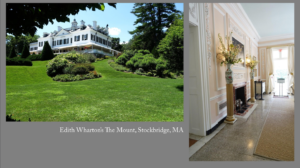
- Naumkeag (1885-1886). A 44-room “Berkshire cottage” in Stockbridge (southwest Massachusetts), constructed in 1885-1886 to a design by McKim, Mead & White, who later became famous for such NYC landmarks as the original Penn Station and the campus of Columbia University. The official site is here; my album of photos is here. It includes an early work by MacMonnies, in the sort of site it was designed for (rather than a museum).
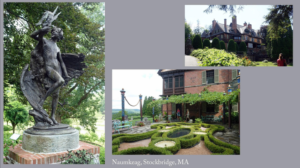
Runners-up:
- Pantheon, Rome (a.k.a. Basilica di Santa Maria ad Martyres) (126 AD?). The Pantheon has been on my must-see list for a very long time. The date of its construction and its original function are both uncertain, but the building itself is marvelous. The height of the dome (142 feet) precisely equals its diameter. The Pantheon is one of the best-preserved Roman buildings because by the early seventh century, it had been repurposed as a Christian church. It has been the inspiration for innumerable later buildings, including many late nineteenth-century banks and libraries.
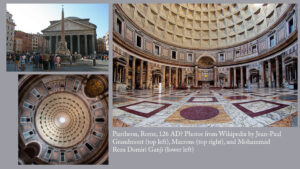
- * Guas, Juan, architect. Ceilings of San Juan de los Reyes, Toledo (1477-1504): here and here. I adore ceilings in the “Flamboyant Gothic” style for their symmetry and exuberance. This example is from a monastery in Toledo, Spain, that was commissioned by the “Catholic Monarchs”, Isabella and Ferdinand, who later bankrolled Columbus’s voyages. San Juan de los Reyes was badly damaged by Napoleon’s troops, abandoned in 1835, and painstakingly restored from 1883 to 1967. For examples of similar amazing ceilings, do a Google search of “Flamboyant Gothic ceilings images”.
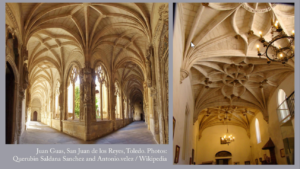
- * Compte, Pere. Lonja de Seda, Valencia (1483). Oh, Dianne, not another cathedral! No, not another cathedral. “Lonja de Seda” means “silk exchange”. This building was constructed on the cusp of the Middle Ages / Renaissance, and like the Palazzo Vecchio in Florence and the Doge’s Palace in Venice, it was built for commerce. Cities on the Mediterranean such as Venice, Barcelona, and Valencia were centers of European trade with the East (including silk) until Columbus and other discoverers opened up sea routes to Asia. Around the interior of the main hall, with its enormous spiral columns, runs a Latin inscription in gilt letters that’s also on the cusp of medieval and modern. In this photo, you can see it as a dark band halfway up the wall. Translated: “I am a celebrated house built in fifteen years. Look and see, my fellow-citizens, how good trade is when there is no fraud in speech, when it makes promises to the neighbor and does not deceive him, when it does not lend money with an exorbitant charge for its use. The merchant who acts this way will have abundant wealth and in the end will enjoy eternal life.” (The original Latin: “Inclita domus sum annis aedificata quindecim. Gustate et videte concives quoniam bona est negotatio, quae non agit dolum in lingua, quae jurat proximo et non deficit, quae pecuniam non dedit ad usuram eius. Mercator sic agens divitiis redundabit, et tandem vita fructur aeterna.”)
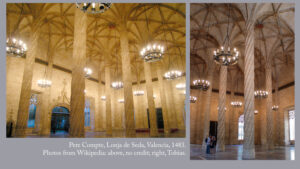
Decorative Arts
Nautilus cup (Metropolitan Museum of Art Favorites) (1602). In the sixteenth and early seventeenth centuries, European rulers vied with each other to collect marvels both manmade and natural. This gorgeous drinking cup was wrought by a Dutch artist using a nautilus shell brought from the Indian Ocean.
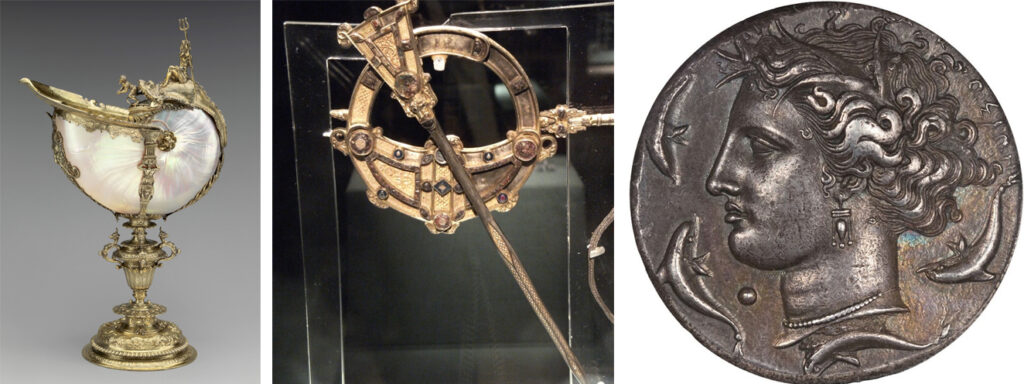
Runners-up:
- Tara Brooch (ca. 650-750): here and here. Before Velcro, before zippers, before buttons, before fitted garments, if you were lucky enough to have a heavy piece of fabric to keep you warm, you held it in place with a brooch: a sharp pin that often had a decorative face-piece. Examples survive from as early as the Bronze Age. A brooch made a statement about your fashion sense and your wealth. And unlike real estate, it was portable and easily hidden. The “Tara Brooch” was made in the depths of the Dark Ages in Ireland and was buried when some unknown invaders approached. I love the fact that even at a time when most men had forgotten to read and were barely subsisting, one artisan took the time to create this intricately detailed piece of decorative art.
- * [Greek]. Coin: decadrachm of Syracuse by Euainetos (ca. 413-400 BC). The Greeks produced not only gorgeous life-size and over-life-size sculptures, but beautiful works on a small scale. Syracuse’s coin-designers Kimon and Euainetos produced this ten-drachma piece, which is considered by many collectors to be the finest coin from the ancient world. One side has the head of Arethusa, the nymph associated with Syracuse; the other has quadrigas (four-horse chariots), which the ruler of Syracuse routinely sponsored in the Olympic Games. One of these coins sold in 2015 for $341,000.
Museums
For a couple years I did posts on my five favorite pieces from a variety of museums. This year I switched to a series of posts on three museums that I’d visited, camera in hand.
- Brookgreen Gardens in Murrells Inlet, SC: Figurative American sculpture of the 19th and 20th centuries.

- Isabella Stewart Gardner Museum in Boston, MA: an eclectic array of art from all times, all places.
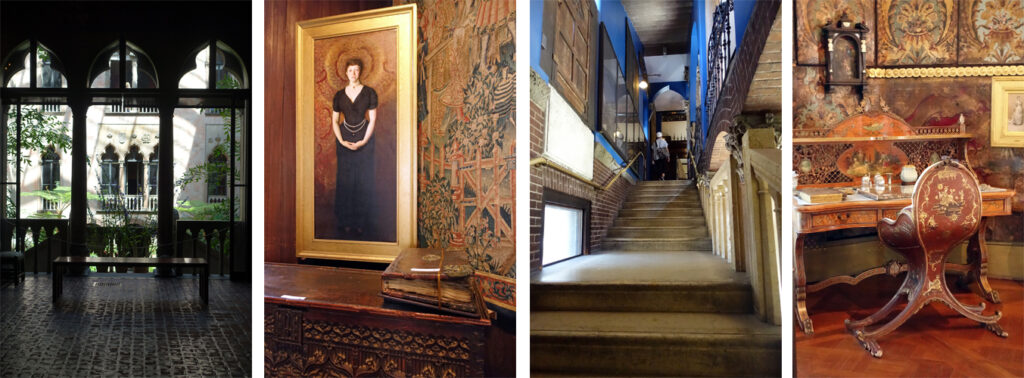
- Wadsworth Atheneum, Hartford, CT: Western art, mostly Renaissance and later, including an excellent collection of Hudson River School paintings. This series is continuing into 2021.

More
- In 2020 I published Innovators in Sculpture and Innovators in Painting, which have been in the works for many years. For why they’re unique, see here. I also published Getting More Enjoyment from Sculpture You Love, an anthology of 16 essays demonstrating how to analyze sculpture. My edition of Henry Kitchell Webster’s Collected Short Works and Related Correspondence, volume 2 (1913-1914) appeared. All these are available in print and Kindle formats via my Amazon author page. For more of my writings, see the list on the Books and Essays page. And check out dozens of videos on my YouTube channel: the three recommendations for the free email list and a video of the blog post are added every week.
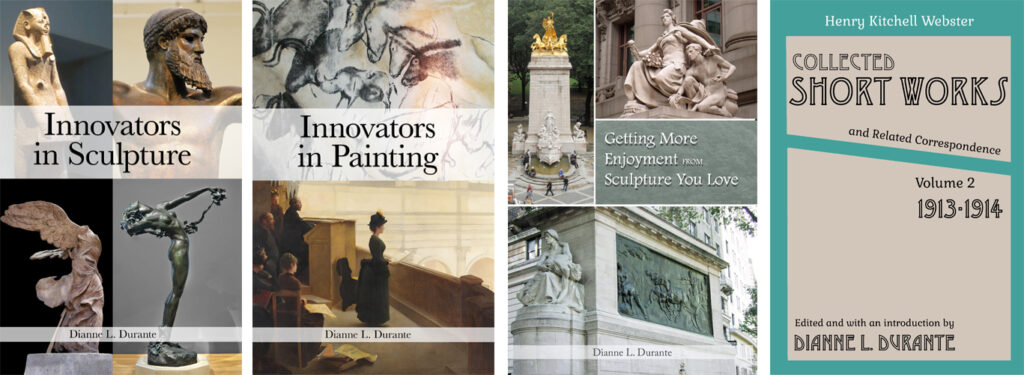
- For favorites from earlier years, see the Favorite Recommendations and Photos link.
- Want wonderful art such as these recommendations delivered weekly to your inbox? Check out my free Sunday Recommendations list and rewards for recurring support: details here.
